ND5 or ND8

Bleed in the event of:
- dead travel,
- pedal at mid-travel,
- pedal to the floor,
- poor gear changing.
I - PRECAUTIONS DURING REPAIR
Risks relating to contamination.
All the operations on the hydraulic clutch circuit system
must be carried out under excellent cleanliness
conditions. This ensures that no impurities enter the
hydraulic circuit during the operation.
The cleanliness principles apply to all components
of the hydraulic clutch circuit.
Items causing contamination are:
- metal or plastic swarf,
- fibres:
- cardboard,
- brushes,
- paper,
- clothing,
- cloth,
- dust and particles in the air,
- etc.
Cleaning cloths.
There are two types of equipment used to bleed the
clutch circuit:
- ARC50 via the brake fluid reservoir.
- Syringe via the bleed hole located on the clutch
slave cylinder.
There are two procedures used to bleed the clutch
circuit:
- If no parts of the hydraulic clutch circuit are removed:
- Carry out the bleed operation using the ARC50 via
the brake fluid reservoir or using a new syringe via
the bleed hole located on the clutch slave cylinder.
- If no parts of the hydraulic clutch circuit are removed:
- Only carry out the bleed operation using a new syringe
by injecting the brake fluid via the bleed hole
on the clutch slave cylinder.
Note:
- Even the tiniest air bubble in the circuit can
cause faulty operation (pedal failing to return
properly, crunching sound when changing gear,
etc.).
- Incorrect bleeding can lead to incorrect detection
of faults and unnecessary part replacements.
|
Consumables required for the repair:
- Bleed the clutch circuit using approved (see Vehicle:
Parts and consumables for the repair) brake
fluid (04B, consumables - products).
II - PREPARATION OPERATION
- Position the vehicle on a two-post lift (see Vehicle:
Towing and lifting) (02A, Lifting equipment).
- Remove the engine undertray.
There are several versions of bleed screw:
Screw type bleed screw.
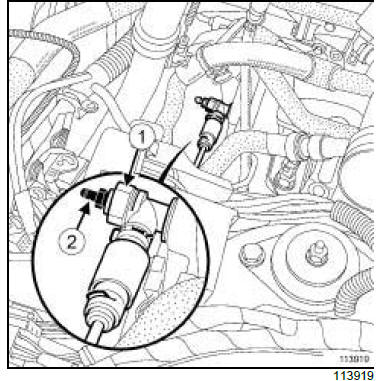
- To open the bleed screw, hold the plastic union (1)
using a ring spanner and undo the bleed screw (2) .
Half-turn bleed screw.
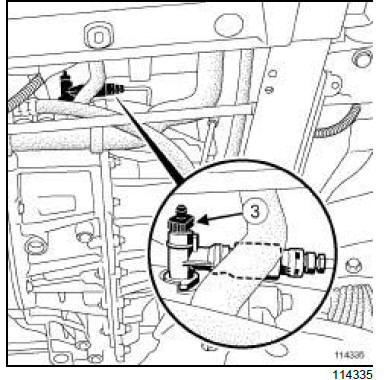
- To open the bleed screw, fully turn the bleed screw
(3) by hand.
Bleed screw with a clip.
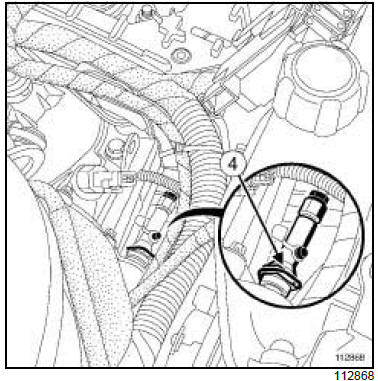
- To open the bleed screw, press and hold the clip (4)
while pulling by one notch.
Bleed screw with a clip.
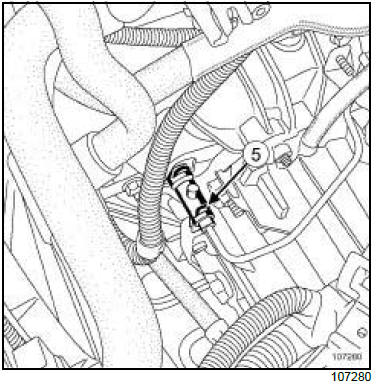
- To open the bleed screw, lift the clip (5) while pulling
by one notch.
Bleed screw with two clips.
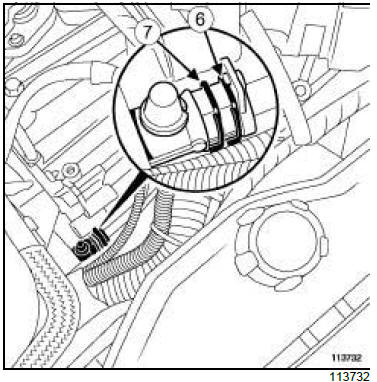
- To open the bleed screw, lower the clip (6) and lift
the clip (7) while pulling by one notch.
III - BLEED PROCEDURE IF NO PARTS OF THE
HYDRAULIC CIRCUIT ARE REMOVED
1 - Bleed using the ARC50.
- Keep the clutch pedal in the upper position using a
strap attached to the steering wheel to ensure continuity
of the hydraulic circuit during the bleed operation.
| Note:
Take care not to disrupt the adjustment of the
clutch start of travel switch. |
- Connect the brake circuit bleeding device (after
having received Renault approval) to the master cylinder
reservoir (see the instructions for the equipment).
- Remove the bleed plug from the clutch slave cylinder.
- Connect a transparent pipe to the bleed hole running
to an empty container placed under the bleed hole.
- Open the bleed screw.
- Open the circuit between the bleeding device and
the brake fluid reservoir.
- Let the brake fluid run until all air bubbles have been
released.
- Stop the bleeding device to dump the pressure in the
clutch circuit.
- Close the bleed screw.
- Remove the transparent pipe from the bleed hole.
- Refit the bleed plug.
- Top up the brake fluid level in the master cylinder
reservoir after disconnecting the bleed device.
- Disengage and engage the clutch quickly around
twenty times.
- Check that the clutch system is operating correctly.
- Repeat the bleed operation if necessary.
- Check the adjustment of the switch. (see 37A, Mechanical
component controls, Clutch pedal
switch: Removal - Refitting, page 37A-61) (37A,
mechanical control elements).
2 - Bleed using a new syringe.
- Keep the clutch pedal in the upper position using a
strap attached to the steering wheel to ensure continuity
of the hydraulic circuit during the bleed operation.
| Note:
Take care not to disrupt the adjustment of the
clutch start of travel switch. |
- Remove the bleed plug from the clutch slave cylinder.
- Connect a transparent pipe of sufficient length to the
bleed hole (at least thirty centimetres) in order to
place it at the same height as the reservoir.
- Open the bleed screw.
- Fill the brake fluid master cylinder reservoir until
brake fluid flows out of the bleed screw.
| Note:
The transparent pipe must remain at the same
height as the master cylinder reservoir to prevent
air from entering inside the clutch circuit. |
- Connect a new hydraulic circuit bleed syringe
filled with a useful volume of 60 ml of approved
brake fluid to the end of the transparent pipe.
- Slowly inject the entire contents of the syringe into
the hydraulic clutch circuit without injecting any of
the air from the top section of the syringe.
- Close the bleed screw.
- Remove the transparent pipe from the bleed hole.
- Refit the bleed plug.
- Top up the brake fluid level in the master cylinder
reservoir.
- Disengage and engage the clutch quickly around
twenty times.
- Check that the clutch system is operating correctly.
- Repeat the bleed operation if necessary.
- Check the adjustment of the switch. (see 37A, Mechanical
component controls, Clutch pedal
switch: Removal - Refitting, page 37A-61) (37A,
mechanical control elements).
IV - BLEED PROCEDURE IF PARTS OF THE
HYDRAULIC CIRCUIT ARE REMOVED.
| WARNING
The master cylinder pipe must be disconnected
from its take-off point on the brake fluid reservoir,
to avoid any foreign matter penetrating inside the
hydraulic brake circuit. |
| WARNING
Prepare for the flow of fluid and protect the surrounding
components. |
| Note:
Prefill the hydraulic circuit pipe equipped with a
filter.
Position the filter head facing downwards to
ensure that it fills. |
There are several versions of pipe with and without
a filter:
Pipe without filter.
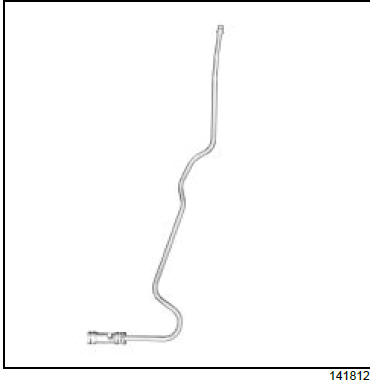
Filling position for pipe with filter.
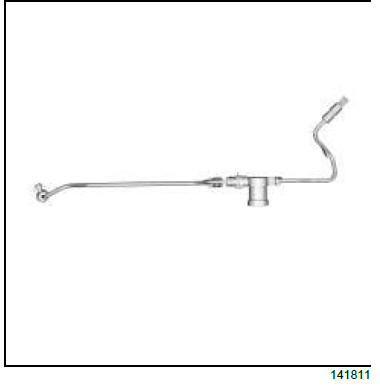
Filling position for pipe with filter.
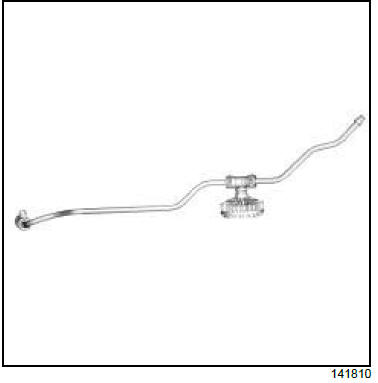
Filling position for pipe with filter.
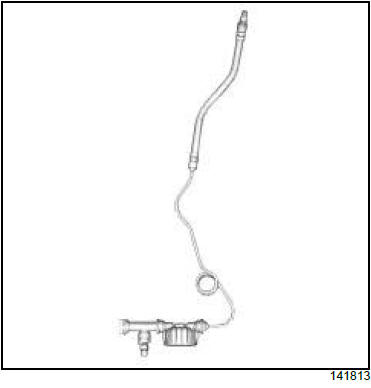
- Prefill the clutch pipe using the syringe.
- Plug the prefilled pipe on the master cylinder end to
stop any brake fluid from escaping.
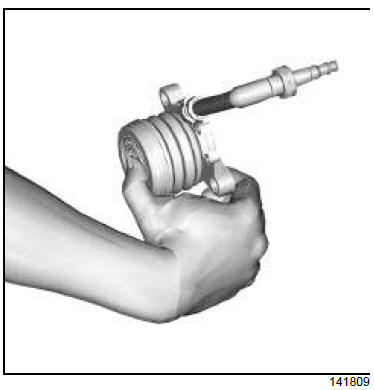
- Prefill the hydraulic tappet using the new syringe (by
gravity).
- Refit the part(s) concerned.
V - BLEED PROCEDURE AFTER A REMOVING A
COMPONENT OF THE HYDRAULIC CIRCUIT.
- Keep the clutch pedal in the upper position using a
strap attached to the steering wheel to ensure continuity
of the hydraulic circuit during the bleed operation.
| Note:
Take care not to disrupt the adjustment of the
clutch start of travel switch. |
- Remove the bleed plug from the clutch slave cylinder.
- Connect a transparent pipe of sufficient length to the
bleed hole (at least thirty centimetres) in order to
place it at the same height as the reservoir.
- Open the bleed screw.
- Fill the brake fluid master cylinder reservoir until
brake fluid flows out of the bleed screw.
| Note:
The transparent pipe must remain at the same
height as the master cylinder reservoir to prevent
air from entering inside the clutch circuit. |
- Connect a new syringe containing 60 ml of approved
brake fluid to the end of the transparent pipe.
- Slowly inject the entire contents of the syringe into
the hydraulic clutch circuit without injecting any of
the air from the top section of the syringe.
- Close the bleed screw.
- Remove the transparent pipe from the bleed hole.
- Refit the bleed plug.
- Top up the brake fluid level in the master cylinder
reservoir.
- Disengage and engage the clutch quickly around
twenty times.
- Check that the clutch system is operating correctly.
- Repeat the bleed operation if necessary.
- Check the adjustment of the switch. (see 37A, Mechanical
component controls, Clutch pedal
switch: Removal - Refitting, page 37A-61) (37A,
mechanical control elements).
VI - FINAL OPERATION
- Refit the engine undertray.
- Remove the vehicle from the two-post lift (see Vehicle:
Towing and lifting) (02A, Lifting equipment).
|













